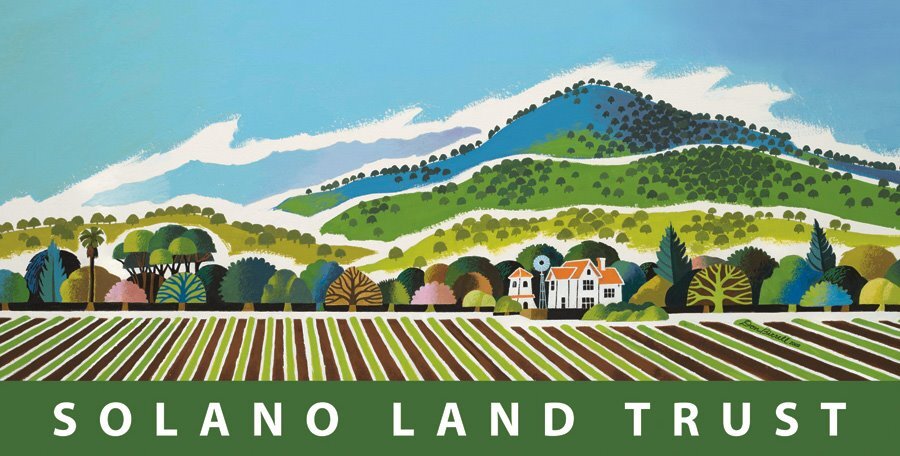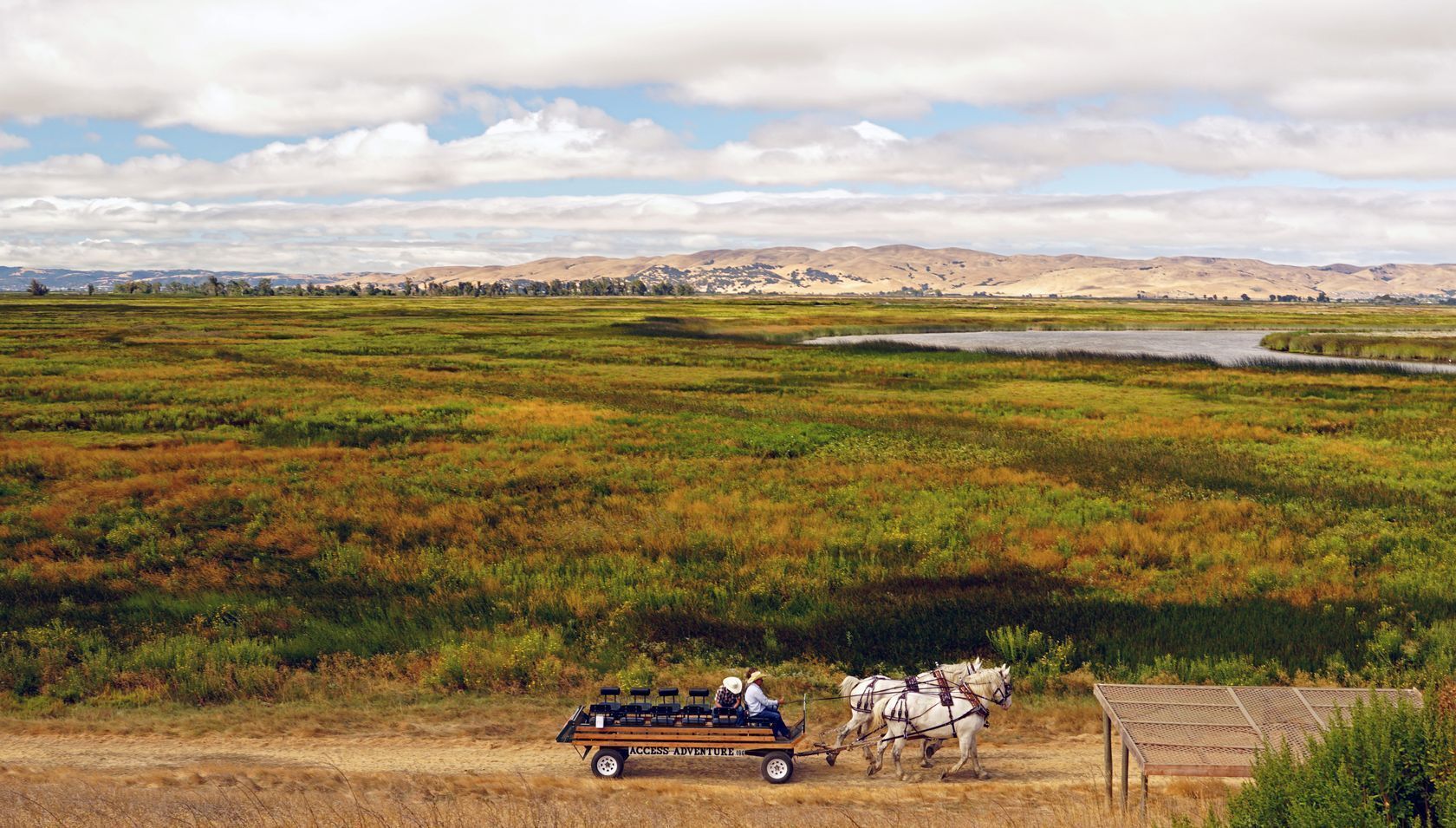Welcome to Rush Ranch
Nestled at the edge of Suisun Marsh, Rush Ranch is a vital link between the land and sea, showcasing one of California’s largest brackish marshes. This protected open space, managed by Solano Land Trust, offers visitors a chance to immerse themselves in nature, explore miles of trails, and connect with the region’s history.
Designated as a National Estuarine Research Reserve, Rush Ranch supports critical research on marsh ecosystems, serves as a hub for community education, and provides a refuge for countless species of plants and animals.
"Rush Ranch Wins Hearts." That could be the headline for any story about Rush Ranch. Whether you're a child or an adult, a hiker, birdwatcher, biologist, teacher, photographer, poet or painter, or just out for a picnic, this Solano Land Trust jewel will win you over.
Rising out of the northeast edge of the Suisun Marsh, Rush Ranch stretches across 2,070 acres of marsh and rolling grassland. Purchased in 1988 by Solano Land Trust, Rush Ranch provides recreational and educational opportunities to thousands of visitors each year. The Ranch, with its historical buildings and self-guided trails, is located approximately two miles south of Highway 12 on Grizzly Island Road.
Key Features
-
Learn about the Marsh
Within the property’s boundaries is one of the best remaining examples of a brackish tidal marsh habitat in the United States. Once a continuous tidal marsh habitat, the greater Suisun Marsh is now a vast complex of wetlands owned privately by local duck clubs. Only about 10 square miles of the historic tidal marsh remains, one-tenth of which occurs at Rush Ranch.
What’s special about a brackish tidal marsh? It is an important habitat for fish, bird and plant species, including many that are threatened and endangered such as the salt marsh harvest mouse, Suisun ornate shrew, Delta smelt, Sacramento splittail, giant garter snake, California clapper rail, California black rail, Suisun song sparrow, and the American white pelican. Approximately 230 different species of birds have been seen throughout the marsh and grassland habitats, and plant communities range from spring wildflowers to native bunchgrass and marsh-adapted vegetation. -
Cultural Heritage
Visit the Blacksmith Shop and Bay Area Barns to learn about traditional crafts and ranching history. Engage with hands-on demonstrations during special events and experience the living legacy of Rush Ranch’s agricultural roots.
Before European settlement, Patwin Native Americans summered on the property for thousands of years. The Suisunes, a sub tribe of the Patwins, likely hunted tule elk, grizzly bears and waterfowl, fished in the Suisun slough, and gathered plants for food and medicine. It is estimated that there were about 2,300 Patwins living in the area of Solano County in 1800, but the population soon plummeted to zero due to disease, forced moves to Spanish Missions and battles with Europeans. By 1823, there were no observed Native Americans left in the area, only abandoned and destroyed village sites.
For most of the 20th century, the ranch was operated by the Rush family, and unlike other landowners adjacent to the Suisun Marsh, they did not dike or otherwise significantly alter the tidal action on their property. With most tidal marshes in the United States managed or filled, their decision to leave the marsh to natural tidal ebbs and flows has proven to be an important contribution to tidal marsh science as a premier tidal habitat and in protecting plant and animal species of the marsh.
Purchased by Solano Land Trust in 1988 with a grant from the Coastal Conservancy, Rush Ranch was designated as part of the San Francisco Bay National Estuarine Research Reserve in 2003. Solano Land Trust works in close partnership with the Rush Ranch Educational Council, an all-volunteer nonprofit organization that promotes education and public outreach programs for the ranch. -
Suisun Marsh Wildlife
Rush Ranch is a hotspot for biodiversity, home to:
Salt Marsh Harvest Mouse: An endangered species unique to tidal wetlands.
Birdlife: A paradise for birdwatchers, with species like the white-tailed kite, great blue heron, and marsh wren.
Flora: Native grasses and wetland vegetation adapted to brackish waters. -
Scenic Trails and Outdoor Recreation
Explore over 3 miles of trails, including:
Marsh Trail: A flat, accessible path with sweeping views of the Suisun Marsh.
South Pasture Trail: A scenic route through rolling grasslands.
Hill Slough Trail: For a more adventurous hike with panoramic vistas. -
Educational Programs and Events
Rush Ranch offers numerous opportunities for learning and community engagement, including:
• Monthly guided nature walks and marsh tours.
• Family-friendly events like "Get the Rush."
• Field trips for students focused on ecology and conservation.
Plan Your Visit
Hours of Operation
Rush Ranch is open to the public 7 days a week year-round. Open hours are 8am to 5pm November 1 through February 28, and 8:00am to 7:00pm March 1 through October 31.
Directions
Located approximately 2 miles south of Suisun City along Grizzly Island Road. Parking and restrooms are available at the main entrance. (View on Google Maps)
Rules and Guidelines
- Dogs are allowed on-leash only on the Suisun Hill Trail, on the entrance road, and around the Rush Ranch buildings.
- No dogs are allowed on the Marsh Trail or the South Pasture Trail.
- Help protect the environment by staying on designated trails.
- No fishing, hunting, or off-road vehicles are permitted.
Educational & Conservation Importance
Rush Ranch plays a critical role in preserving the Suisun Marsh, which filters water, supports regional biodiversity, and mitigates climate change impacts. By visiting and supporting Rush Ranch, you contribute to the stewardship of this extraordinary ecosystem for future generations.
Research at Rush Ranch
All scientific research must be approved in advance. To request a permit for scientific research at Rush Ranch, CLICK HERE.
Trail Closure Notice
Please note that the Marsh Trail is closed where it crosses the levee to Goat Island due to safety concerns. The levee has become degraded in multiple places and is beyond typical small-scale repairs. As Solano Land Trust staff, our partners at the National Estuarine Research Reserve (NERR), and others consider public access options as part of a larger effort to restore Goat Island Marsh, public feedback is welcome.

